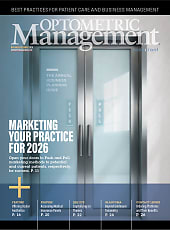HUMAN ADENOVIRUSES (HAdVs) are nonenveloped, double-stranded DNA viruses (Russell, 2009). They are extremely resistant to environmental desiccation and disinfectants and stay infectious for extended periods on various surfaces, including eye-drop bottles and other plastics and metals (Gordon et al, 1993; Nauheim et al, 1990; Uchio et al, 2002). Human adenoviruses are divided phylogenetically into 7 species (A to G); HAdV-D and HAdV-E cause ocular conditions (Ismail et al, 2018).
Although human adenoviruses are the primary cause of acute viral conjunctivitis, limited data exist on the effectiveness of contact lens-care products against these viruses. A recent study assessed the antiviral efficacy of commercially available contact lens-care solutions against human adenovirus type 5 (Ad5) (Nogueira et al, 2025).Quantitative suspension tests were performed on Ad5 solutions mixed with each of 6 different contact lens care solutions for 4 or 6 hours. For the hydrogen peroxide system, additional interaction times of 0, 2, 4, and 6 hours were examined before neutralization. In this study, quantitative suspension tests revealed that povidone-iodine (PVP-I)-based products significantly reduced Ad5 after 4 hours of incubation, while the rub-and-rinse solutions and 3% hydrogen peroxide solutions required 6 hours to show significant reduction of Ad5 in lab testing.
The study also examined the binding of Ad5 to contact lenses and evaluated the effectiveness of rub-and-rinse solutions to remove the virus from lens surfaces.A hydrogel and silicone hydrogel material were eachtested in triplicate. The day before each experiment, lenses were removed from their packaging and soaked overnight in Dulbecco’s phosphate-buffered saline (DPBS). The following day, individual lenses were immersed in 4 mL of Ad5 suspension (10⁶ MPN/mL) and incubated at room temperature for 6 hours. As a control, the Ad5 suspension was incubated under the same conditions without contact lenses.
Lenses were then cleaned with each solution using 2 methods. Non-oxidative (multipurpose) solutions were tested in 2 ways: by simply rinsing the contaminated lenses, and by rubbing and rinsing the lenses. Hydrogen peroxide cleaner was tested by rinsing before the 6-hour disinfection, and without the rinsing step before disinfection. The PVP-I solutions were used for the normal 4-hour disinfection, both with and without the final rinse step.
Results showed that rinsing alone with non-oxidative solutions did not significantly reduce the Ad5 load, but adding the rubbing step resulted in no detectable virus when tested. PVP-I solution use effectively reduced the virus load to undetectable levels, both with and without the final rinsing step. Hydrogen peroxide, however, did not reduce the viral load with either the disinfection step or with the addition of rinsing before disinfection.
The results also demonstrated that various lens materials, including conventional hydrogel, silicone hydrogel, and rigid lenses, were equally susceptible to Ad5 contamination. Notably, this study found that incorporating a rub-and-rinse step before overnight disinfection significantly improved the performance of non-oxidative disinfection systems against Ad5. These findings highlight the importance of adhering to recommended care regimens to effectively eliminate infectious adenovirus from contact lens materials.
References
1. Russell WC. Adenoviruses: Update on structure and function. J Gen Virol. 2009;90:1-20. doi: 10.1099/vir.0.003087-0
2. Gordon YJ, Gordon RY, Romanowski E, et al. Prolonged recovery of desiccated adenoviral serotypes 5, 8, and 19 from plastic and metal surfaces in vitro. Ophthalmology. 1993;100:1835-1839. doi: 10.1016/s0161-6420(93)31389-8
3. Nauheim RC, Romanowski EG, Araullo-Cruz T, et al. Prolonged recoverability of desiccated adenovirus type 19 from various surfaces. Ophthalmology. 1990;97:1450-1453. doi: 10.1016/s0161-6420(90)32389-8
4. Uchio E, Ishiko H, Aoki K, et al. Adenovirus detected by polymerase chain reaction in multidose eyedrop bottles used by patients with adenoviral keratoconjunctivitis. Am J Ophthalmol. 2002;134:618-619. doi: 10.1016/s0002-9394(02)01599-4
5. Ismail AM, Cui T, Dommaraju K, et al. Genomic analysis of a large set of currently—and historically—important human adenovirus pathogens. Emerg Microbes Infect. 2018;7:10.
6. Nogueira CL, Boegel SJ, Shukla M, Ngo W, Hui A, Jones LW, Aucoin MG. Antiviral activity of contact lens care solutions and rub-and-rinse regimen against adenovirus. Optom Vis Sci. 2025 Mar 1;102(3):156-166. doi: 10.1097/OPX.0000000000002231. Epub 2025 Feb 5. PMID: 39903204; PMCID: PMC11939091.
7. Nogueira CL, Boege lSJ, Shukla M, et al. The impact of a rub and rinse regimen on removal of human coronaviruses from contemporary contact lens materials. Cont Lens Anterior Eye. 2022;45:101719.




